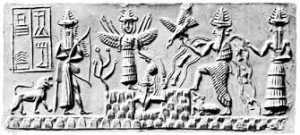WHO IS SHAMASH?
Shamash (Utu in Sumerian) was the god of the sun, his ancient Sumerian ideogram consisted of a solar disk between two mountain peaks. His residence was the É-Babbar (House shining) in the city of Sippar in the kingdom of Akkad; elsewhere important for God was Larsa with a Ziqqurat, called é-dur-an-ki (house ligament of heaven and earth) in Sumer. His paredra was the Goddess Aja (Sherida in Sumerian). In Sumerian tradition is presented as the son of Nanna and Ningal together Iskur / Adad and Inanna / Ishtar, while in the Akkadian tradition was son of An and Enlil. Along with the god Sin and the goddess Ishtar he forms the triad of astral deities.
POWER
Besides being the Sun God, Shamash is considered the God of justice, as with his light illuminates the enemies and bad actions. In fact, in the code of Hammurabi is Shamash to be represented on the stele as a guarantor of justice, also it was placed in his temple. Several centuries before Hammurabi, Ur-Engur Dynasty of Ur (2600 BC) claimed to have made decisions according to the just laws of Shamash. This God was also linked to divination. In the Mesopotamian world the universe has its own order created by the gods, idea clearly expressed in epithets of the same, defined as “those who trace the cosmic projects.” Shamash, appears in the ritual and diviners texts as “the king of heaven and Earth, Judge [of the regions] of above and below, guide the living, the one who walks away spells, signs and bad omens,” , he is also called “creator of what is above and what is below “
MYTHOLOGY
In the myths he acts as God-protector. In the myth of Gilgamesh, the God helps the hero through premonitory dreams to defeat the guardian of the cedar forest, Huwawa. In the Sumerian text “the dream of Dumuzi” the protagonist escapes from Galla demons who want to drag into the underworld thanks to Shamash. Finally we find him also in the myth of Etana, the latter is rescued by this God to succeed in his business, or find the herb of fertility.
ICONOGRAPHY
In the vision Mesopotamian Shamash was imagined on a cart pulled by mules with which crosses the sky. The figurative representations of the sun-god already appear on prehistoric seals of the third millennium, which is dominated the appearance of fertility: he is shown on the boat with rays emanating from his shoulders and serrated weapon in hand. On the seals of the Akkadian period instead always has the tiara, the long dress open at the front, the beard, the weapon and curved beams outgoing rounded shoulders, with one foot resting on the mountain while the two assistants open the doors of heaven. Here is the beginning of every new day. In other representations of the god he is in the role of warrior victorious, triumphant on an opponent that has the look of a man-bull, regarded as the god of light that overcomes the powers of darkness.
CHI È SHAMASH?
Shamash (in sumerico Utu) era il Dio del sole, il suo antico ideogramma sumerico consisteva in un disco solare tra due cime di montagne. La sua residenza era l’É-Babbar (Casa splendente) nella città di Sippar nel regno di Akkad; altra sede importante per il Dio era Larsa con una ziqqurat detta é-dur-an-ki (casa del legamento del cielo e della terra) nel Sumer. Sua paredra era la Dea Aja (Sherida in sumerico). Nella tradizione sumerica viene presentato come figlio di Nanna e Ningal insime a Iskur/Adad e Inanna/Ishtar, mentre in quella accadica figlio di An o Enlil. Insieme al dio Sin e la dea Ishtar egli forma la triade delle divinità astrali.
POTERE
Oltre ad essere il Dio del sole, Shamash è considerato il Dio della giustizia, in quanto con la sua luce illumina i nemici e le azioni cattive. Infatti nel codice di Hammurabi è Shamash ad essere rappresentato sulla stele come garante di giustizia, inoltre quest’ultima venne posta nel suo tempio. Diversi secoli prima di Hammurabi, Ur-Engur della dinastia di Ur ( 2600 a.C.) dichiarò di aver reso le decisioni secondo le giuste leggi di Shamash. Questo Dio inoltre era legato anche alla divinazione. Nel mondo mesopotamico l’universo possiede un proprio ordine creato dagli Dei, idea chiaramente espressa negli epiteti degli stessi, definiti come “coloro che tracciano i progetti cosmici”. Shamash, compare nei testi rituali e divinatori come “il re del cielo e della Terra, giudice [delle regioni] di sopra e di sotto, guida dei vivi, colui che allontana i sortilegi, i segni e i cattivi presagi”, è chiamato anche “creatore di ciò che è in alto e ciò che è in basso”.
MITOLOGIA
Nei miti egli agisce come Dio-protettore. Nel mito di Gilgamesh, il Dio aiuta l’eroe attraverso sogni premonitori a sconfiggere il guardiano della foresta dei cedri, Huwawa. Nel testo sumerico “il sogno di Dumuzi” il protagonista fugge dai demoni Galla che lo vogliono trascinare negli Inferi grazie a Shamash. Infine lo troviamo anche nel mito di Etana , quest’ultimo viene soccorso da questo Dio per riuscire nella sua impresa, ovvero trovare l’erba della fertilità.
ICONOGRAFIA
Nella visione mesopotamica Shamash veniva immaginato su un carro trainato da muli con cui attraversa il cielo. Le rappresentazioni figurative del dio-sole appaiono già su sigilli protostorici del III millennio, dove predomina l’aspetto della fecondità: egli è raffigurato sulla barca con i raggi uscenti dalle sue spalle e l’arma seghettata in mano. Sui sigilli di epoca accadica invece ha sempre la tiara, la lunga veste aperta sul davanti, la barba, l’arma ricurva e i fasci raggiati uscenti dalle spalle, con un piede poggiante sulla montagna mentre due assistenti gli aprono le porte del cielo. Qui rappresenta l’inizio di ogni nuovo giorno. In altre raffigurazioni il dio è nelle vesti di guerriero vittorioso, trionfante su un avversario che ha l’aspetto di un uomo-toro, considerato come il dio della luce che vince le potenze delle tenebre.
